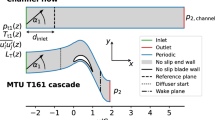Abstract
An in-house large eddy simulation code based on three-dimensional compressible N-S equations was used to research the evolution process of the boundary layer in the low-pressure turbine T106A cascade. Analyses of the separation and reattachment phenomenon as well as the unsteady aerodynamic characteristic on the suction surface at different Reynolds numbers were performed. A variation range of Reynolds number which is based on the exit isentropic velocity and axial chord length extends from 0.6 × 105 to 2.0 × 105. The time-averaged wall-static pressure coefficient compares well with the experimental and DNS data. The effect of Reynolds number on the flow field is mainly embodied at the rear part of the suction side. At low Reynolds number condition, the value of the total pressure loss and the width of the wake are significantly large. With the increase of Reynolds number, the wake zone becomes narrower and the wake centerline moves to the pressure side. The size of separation bubble at the leading edge grows slightly and the coherent structures are more close to the cascade surface. At the case of Re = 2.0 × 105, the two-dimensional shear layer evolves directly into small-scale vortices, whereas the rolling of spanwise vortex and hairpin vortex generation do not appear.











Similar content being viewed by others
References
Hodson HP, Howell RJ (2005) The role of transition in high-lift low-pressure turbines for aeroengines. Prog Aerosp Sci 41(6):419–454
Mayle RE (1991) The role of laminar-turbulent transition in gas turbine engines. J Turbomach 113(4):509–536
Michalek J, Straka P (2013) A comparison of experimental and numerical studies performed on a low-pressure turbine blade cascade at high-speed conditions, low Reynolds numbers and various turbulence intensities. J Therm Sci 22(5):413–423
Simoni D, Ubaldi M, Zunino P, Ampellio E (2016) Free-stream turbulence effects on the boundary layer of a high-lift low-pressure turbine blade. J Therm Sci 25(3):195–206
Opoka MM, Hodson HP (2008) Experimental investigation of unsteady transition processes on high-lift T106A turbine blades. J Propul Power 24(3):424–432
Kürner M, Schneider C, Rose MG, Stephan S, Jochen G. LP Turbine Reynolds lapse phenomena: time averaged area traverse and multistage CFD. ASME Paper 2010, GT2010-23114
Coull JD, Thomas RL, Hodson HP (2010) Velocity distributions for low pressure turbines. J Turbomach 132(4):41006-1–13
Marks CR, Sondergaard R, Bear P, Wolff M (2016) Reynolds number effects on the secondary flow of profile contoured low pressure turbines. In: 54th AIAA aerospace sciences meeting
Treuren KV, Pharris T, Hirst O (2018) Using turbulence intensity and Reynolds number to predict flow separation on a highly loaded, low-pressure gas turbine blade at low Reynolds numbers. ASME Paper 2018, GT2018-75976
Vázquez R, Antoranz A, Cadrecha D, Armañanzas L (2016) The influence of Reynolds number, Mach number and incidence effects on loss production in low pressure turbine airfoils. ASME Paper 2016, GT2006-91121
Matsui K, Tani N, Furukawa J (2018) LES and RANS prediction of adverse pressure transition on linear turbine cascade for high-fidelity design. In: 2018 AIAA aerospace sciences meeting
Pichler R, Zhao YM, Sandberg RD, Michelassi V, Pacciani R, Marconcini M, Arnone A (2018) LES and RANS analysis of the end-wall flow in a linear LPT cascade, part I: flow and secondary vorticity fields under varying inlet condition. ASME Paper 2018, GT2018-76233
Michelassi V, Wissink JG, Rodi W (2003) Direct numerical simulation, large eddy simulation and unsteady Reynolds-averaged Navier–Stokes simulations of periodic unsteady flow in a low-pressure turbine cascade: a comparison. Proc Inst Mech Eng Part A J Power Energy 217(4):403–411
Pacciani R, Marconcini M, Fadai-Ghotbi A, Lardeau S, Leschziner MA (2011) Calculation of high-lift cascades in low pressure turbine conditions using a three-equation model. J Turbomach 133(3):031016-1–9
Keadle K, McQuilling M. Evaluation of RANS transition modeling for high lift LPT flows at low Reynolds number. ASME Paper 2013, GT2013-95069
Ye J (2008) Large eddy simulation of blade boundary layer spatio-temporal evolution under unsteady disturbances. PhD thesis. Beihang University, Beijing
Wang YF, Sui XM, Zhang K, Xiang XR, Zhao QJ (2018) Effects of incidence angle on a LPT blade boundary layer evolution through large eddy simulation. Proc Inst Mech Eng Part A J Power Energy 232(6):722–734
Berland J, Bogey C, Marsden O, Bailly C (2007) High-order, low dispersive and low dissipative explicit schemes for multiple-scale and boundary problem. J Comput Phys 224(2):637–662
Berland J, Bogey C, Bailly C (2006) Low-dissipation and low-dispersion fourth-order Runge–Kutta algorithm. Comput Fluids 35(10):1459–1463
Stadtmüller P (2001) Investigation of wake-induced transition on the LP turbine cascade T106A-EIZ. DFG-Verbundprojekt Fo 136/11, Version 1.0, Universität der Bundeswehr München
Sandberg RD, Michelassi V, Pichler R et al (2015) Compressible direct numerical simulation of low-pressure turbines—part i: methodology. J Turbomach 137(5):051011-1–10
Michelassi V, Chen LW, Pichler R, Sandberg RD (2015) Compressible direct numerical simulation of low-pressure turbines—part II: effect of inflow disturbances. J Turbomach 137(7):071005-1–12
Sandberg RD, Pichler R, Chen LW (2012) Assessing the sensitivity of turbine cascade flow to inflow disturbances using direct numerical simulation. In: 13th International symposium for unsteady aerodynamics, aeroacoustics and aeroelasticity in turbomachinery (ISUAAAT)
Acknowledgements
This work is supported by the Project ZR2020QE190 supported by Shandong Provincial Natural Science Foundation.
Author information
Authors and Affiliations
Corresponding author
Additional information
Technical Editor: André Cavalieri.
Publisher's Note
Springer Nature remains neutral with regard to jurisdictional claims in published maps and institutional affiliations.
Rights and permissions
About this article
Cite this article
Wang, Y., Wang, F., Song, Y. et al. Compressible large eddy simulation of the boundary layer evolution in a low-pressure turbine cascade at different Reynolds numbers. J Braz. Soc. Mech. Sci. Eng. 43, 222 (2021). https://doi.org/10.1007/s40430-021-02941-6
Received:
Accepted:
Published:
DOI: https://doi.org/10.1007/s40430-021-02941-6




